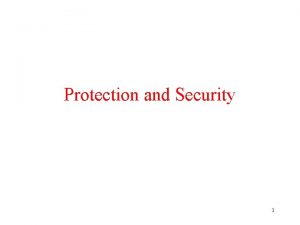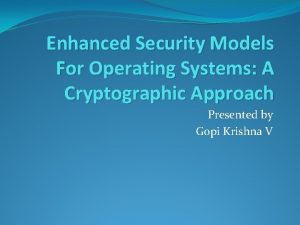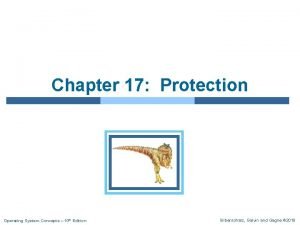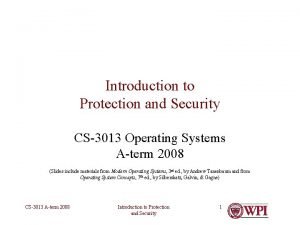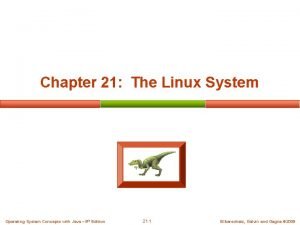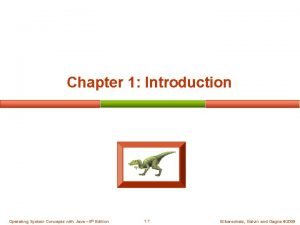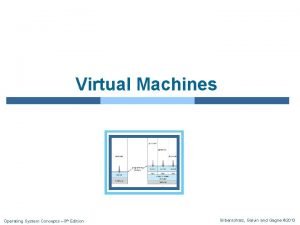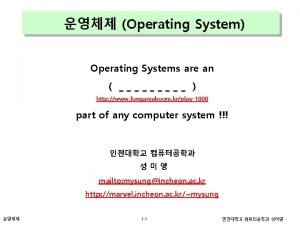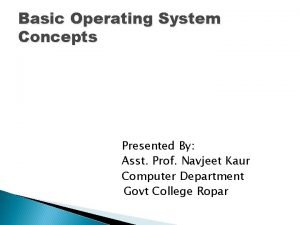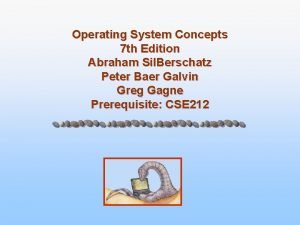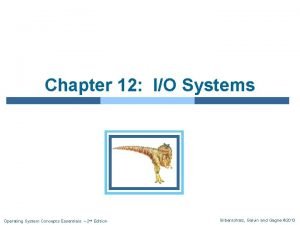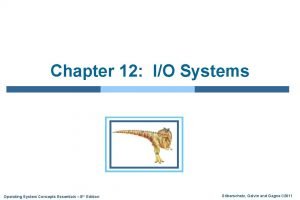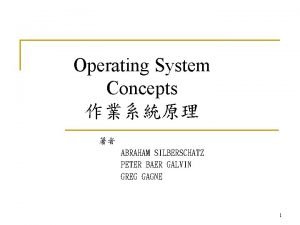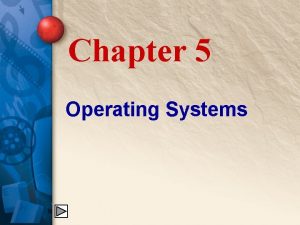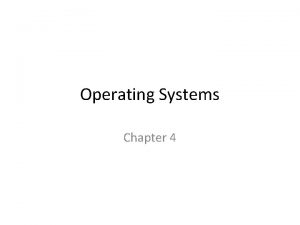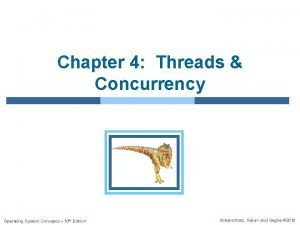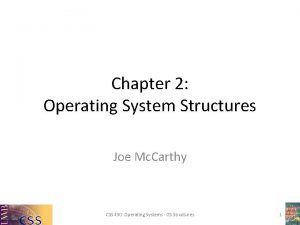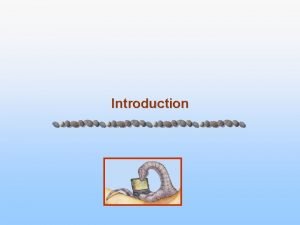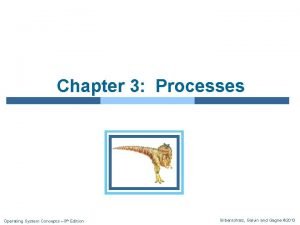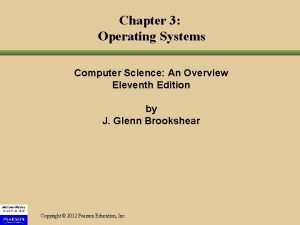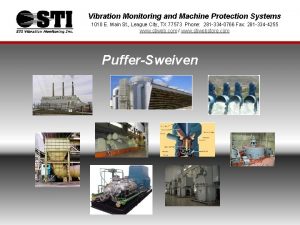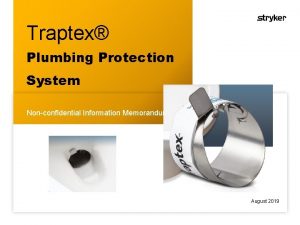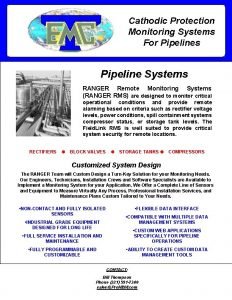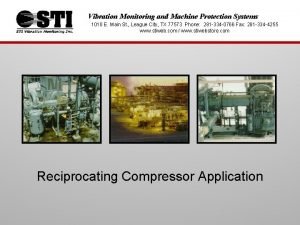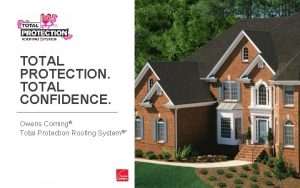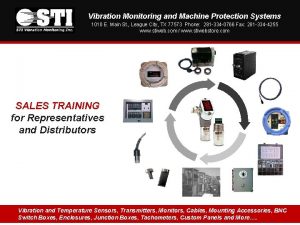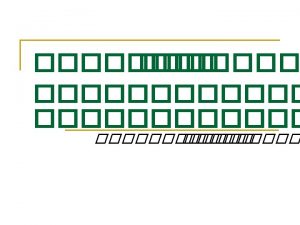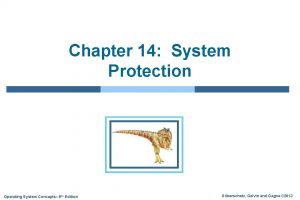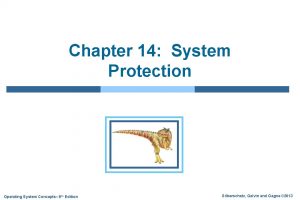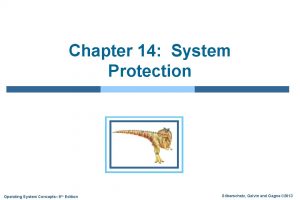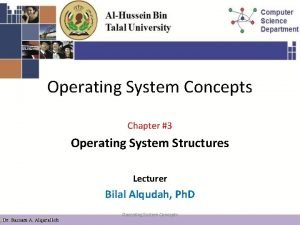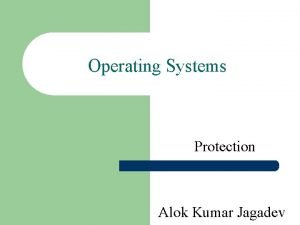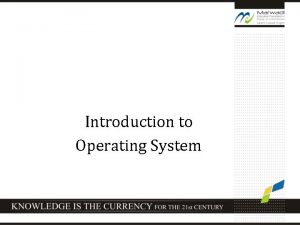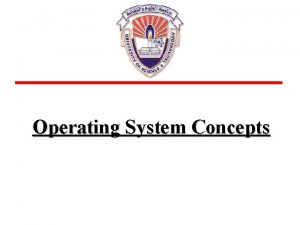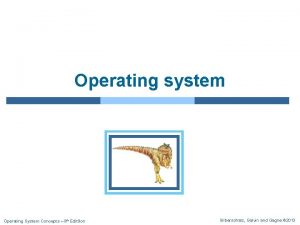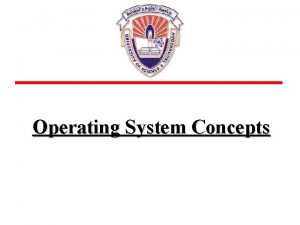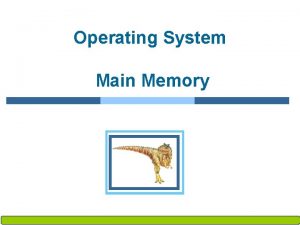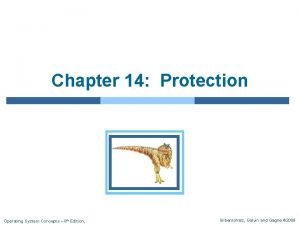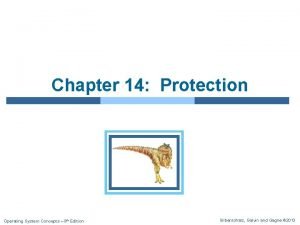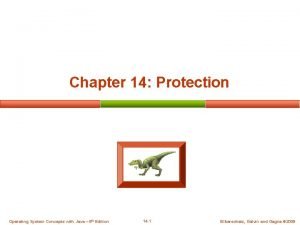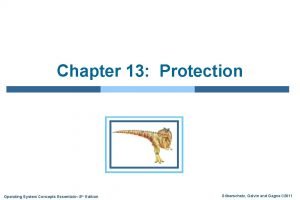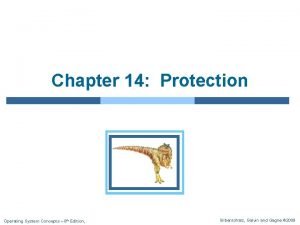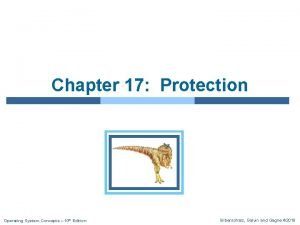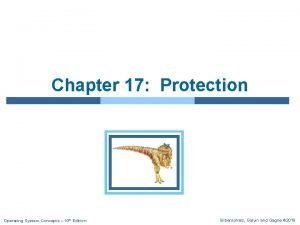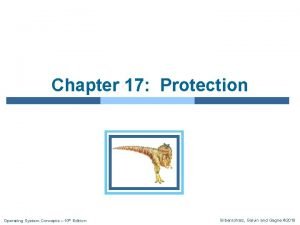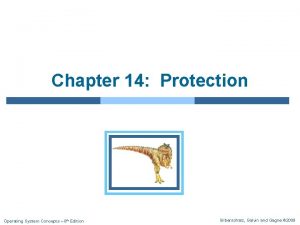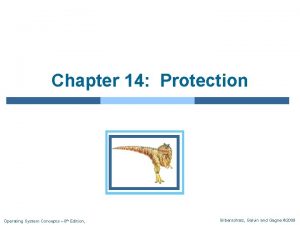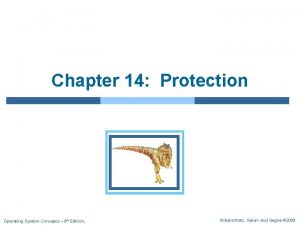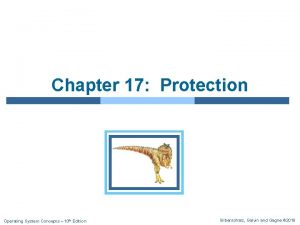Chapter 17 Protection Operating System Concepts 10 th








































- Slides: 40

Chapter 17: Protection Operating System Concepts – 10 th Edition Silberschatz, Galvin and Gagne © 2018

Outline § § § Goals of Protection Principles of Protection Rings Domain of Protection Access Matrix Implementation of Access Matrix Revocation of Access Rights Role-based Access Control Mandatory Access Control (MAC) Capability-Based Systems Other Protection Implementation Methods Language-based Protection Operating System Concepts – 10 th Edition 17. 2 Silberschatz, Galvin and Gagne © 2018

Objectives § Discuss the goals and principles of protection in a modern computer system § Explain how protection domains combined with an access matrix are used to specify the resources a process may access § Examine capability and language-based protection systems § Describe how protection mechanisms can mitigate system attacks Operating System Concepts – 10 th Edition 17. 3 Silberschatz, Galvin and Gagne © 2018

The Protection Problem § A computer system consists of a collection of objects: • Hardware • Software § Each object has a unique name and can be accessed through a well-defined set of operations § Goal - ensure that each object is accessed correctly and only by those processes that are allowed to do so Operating System Concepts – 10 th Edition 17. 4 Silberschatz, Galvin and Gagne © 2018

The Security Problem § System is secure if resources used and accessed as intended under all circumstances • Unachievable § § § Intruders (crackers) attempt to breach security Threat is potential security violation Attack is attempt to breach security Attack can be accidental or malicious Easier to protect against accidental than malicious misuse Operating System Concepts – 10 th Edition 17. 5 Silberschatz, Galvin and Gagne © 2018

The Security/Protection Problem § Both protection and security are vital to computer systems. We distinguish between these two concepts in the following way: § Security is a measure of confidence that the integrity of a system and its data will be preserved. § Protection is the set of mechanisms that control the access of processes and users to the resources defined by a computer system. We focus on protection in this chapter and address security in chapter 16. Operating System Concepts – 10 th Edition 17. 6 Silberschatz, Galvin and Gagne © 2018

Goals of Protection § A computer system consists of a collection of objects, hardware or software § Each object has a unique name and can be accessed through a well-defined set of operations § Protection problem - ensure that each object is accessed correctly and only by those processes that are allowed to do so Operating System Concepts – 10 th Edition 17. 7 Silberschatz, Galvin and Gagne © 2018

Principles of least privilege § Programs, users and systems should be given just enough privileges to perform their tasks § Limits damage if entity has a bug, gets abused § Can be static (during life of system, during life of process) § Or dynamic (changed by process as needed) – domain switching, privilege escalation § “Need to know” a similar concept regarding access to data Operating System Concepts – 10 th Edition 17. 8 Silberschatz, Galvin and Gagne © 2018

Principles of Protection § Must consider “grain” aspect • Rough-grained privilege management easier, simpler, but least privilege now done in large chunks 4 For example, traditional Unix processes either have abilities of the associated user, or of root • Fine-grained management more complex, more overhead, but more protective 4 Access 4 Role Control List (ACL) lists, Based Access Control (RBAC) § Domain can be user, process, procedure Operating System Concepts – 10 th Edition 17. 9 Silberschatz, Galvin and Gagne © 2018

Domain Structure § Access-right = <object-name, rights-set> • rights-set is a subset of all valid operations that can be performed on the object § Domain = set of access-rights § Domains can overlap Operating System Concepts – 10 th Edition 17. 10 Silberschatz, Galvin and Gagne © 2018

Domain Implementation (UNIX) § Domain = user-id § Domain switch accomplished via file system 4 Each file has associated with it a domain bit (setuid bit) 4 When file is executed and setuid = on, then user-id is set to owner of the file being executed 4 When execution completes user-id is reset § Domain switch accomplished via passwords • su command temporarily switches to another user’s domain when other domain’s password provided § Domain switching via commands • sudo command prefix executes specified command in another domain (if original domain has privilege or password given) Operating System Concepts – 10 th Edition 17. 11 Silberschatz, Galvin and Gagne © 2018

Domain Implementation (MULTICS) § Let Di and Dj be any two domain rings § If j < I Di Dj Operating System Concepts – 10 th Edition 17. 12 Silberschatz, Galvin and Gagne © 2018

Multics Benefits and Limits § Ring / hierarchical structure provided more than the basic design : • kernel / user or • root / normal user § Fairly complex -> more overhead § But does not allow strict need-to-know • Object accessible in Dj but not in Di, then j must be < i • But then every object accessible in Di also accessible in Dj Operating System Concepts – 10 th Edition 17. 13 Silberschatz, Galvin and Gagne © 2018

Access Matrix § § View protection as a matrix (access matrix) Rows represent domains Columns represent objects Access(i, j) is the set of operations that a process executing in Domaini can invoke on Objectj Operating System Concepts – 10 th Edition 17. 14 Silberschatz, Galvin and Gagne © 2018

Use of Access Matrix § If a process in Domain Di tries to do “op” on object Oj, then “op” must be in the access matrix § User who creates object can define the access column for that object § Example Operating System Concepts – 10 th Edition 17. 15 Silberschatz, Galvin and Gagne © 2018

Use of Access Matrix § Can be expanded to dynamic protection • Operations to add, delete access rights • Special access rights: 4 copy – ability to copy access-rights from Di to Dj (denoted by “*”) 4 owner – ability to add/remove access-rights 4 control – Di can modify Dj access rights 4 switch – switch from domain Di to Dj • Copy and Owner applicable to an object • Control applicable to domain object Operating System Concepts – 10 th Edition 17. 16 Silberschatz, Galvin and Gagne © 2018

Access Matrix with Copy Rights § A process executing in Domain D 2 can copy the read access to file object F 2 to domain D 3 Operating System Concepts – 10 th Edition 17. 17 Silberschatz, Galvin and Gagne © 2018

Access Matrix with owner Rights § A process executing in Domain D 2 can create the write access-right to file F 2 to domain D 2 and D 3 Operating System Concepts – 10 th Edition 17. 18 Silberschatz, Galvin and Gagne © 2018

Access Matrix with Domains as Objects § A process executing in Domain D 2 can switch to domain D 3 Operating System Concepts – 10 th Edition 17. 19 Silberschatz, Galvin and Gagne © 2018

Mechanism and Policy § Access matrix provides a scheme to separates mechanism from policy • Mechanism 4 Operating system provides access-matrix + rules 4 It ensures that the matrix is only manipulated by authorized agents and that rules are strictly enforced • Policy 4 User – dictates policy Who can access what object and in what mode Operating System Concepts – 10 th Edition 17. 20 Silberschatz, Galvin and Gagne © 2018

Implementation of Access Matrix § Generally, a sparse matrix § Option 1 – Global table • Store ordered triples <domain, object, rights-set> in table • A requested operation M on object Oj within domain Di -> search table for < Di, Oj, Rk > 4 with M ∈ Rk • But table could be large -> will not fit in main memory • Difficult to group objects (consider an object that all domains can read) Operating System Concepts – 10 th Edition 17. 21 Silberschatz, Galvin and Gagne © 2018

Implementation of Access Matrix (Cont. ) § Option 2 – Access lists for objects • Each column implemented as an access list for one object • Resulting per-object list consists of ordered pairs <domain, rights-set> defining all domains with non-empty set of access rights for the object • Easily extended to contain default set -> If M ∈ default set, also allow access Operating System Concepts – 10 th Edition 17. 22 Silberschatz, Galvin and Gagne © 2018

Implementation: Option 2 (Cont. ) § Each column = Access-control list for one object • Defines who can perform what operation Domain 1 = Read, Write Domain 2 = Read Domain 3 = Read § Each Row = Capability List (like a key) • For each domain, what operations allowed on what objects Object F 1 – Read Object F 4 – Read, Write, Execute Object F 5 – Read, Write, Delete, Copy Operating System Concepts – 10 th Edition 17. 23 Silberschatz, Galvin and Gagne © 2018

Implementation of Access Matrix (Cont. ) § Option 3 – Capability list for domains • Instead of list being object based, list is domain based • Capability list for domain is list of objects together with operations allows on them • Object represented by its name or address, called a capability • Execute operation M on object Oj, process requests operation and specifies capability as parameter 4 Possession of capability means access is allowed • Capability list associated with domain but never directly accessible by domain 4 Rather, protected object, maintained by OS and accessed indirectly 4 Like a “secure pointer” 4 Idea can be extended up to applications Operating System Concepts – 10 th Edition 17. 24 Silberschatz, Galvin and Gagne © 2018

Implementation of Access Matrix (Cont. ) § Option 4 – Lock-key • Compromise between access lists and capability lists • Each object has list of unique bit patterns, called locks • Each domain as list of unique bit patterns called keys • Process in a domain can only access object if domain has key that matches one of the locks Operating System Concepts – 10 th Edition 17. 25 Silberschatz, Galvin and Gagne © 2018

Revocation of Access Rights § Various options to remove the access right of a domain to an object • • Immediate vs. delayed Selective vs. general Partial vs. total Temporary vs. permanent Operating System Concepts – 10 th Edition 17. 26 Silberschatz, Galvin and Gagne © 2018

Revocation of Access Rights § Access List – Delete access rights from access list • Simple – search access list and remove entry • Options: 4 Immediate, 4 general 4 total or selective, or partial, 4 permanent Operating System Concepts – 10 th Edition or temporary 17. 27 Silberschatz, Galvin and Gagne © 2018

Revocation of Access Rights (Cont. ) § Capability List – Scheme required to locate capability in the system before capability can be revoked. Not simple since the capabilities are directly accessible to the users. • Reacquisition – periodic delete, with require and denial if revoked • Back-pointers – set of pointers from each object to all capabilities of that object (Multics) • Indirection – capability points to global table entry which points to object – delete entry from global table, not selective (CAL) • Keys – unique bits associated with capability, generated when capability created 4 Master key associated with object, key matches master key for access 4 Revocation – create new master key 4 Policy decision of who can create and modify keys – object owner or others? Operating System Concepts – 10 th Edition 17. 28 Silberschatz, Galvin and Gagne © 2018

Comparison of Implementations § Many trade-offs to consider • Global table is simple, but table can be large and not fit in memory • Access lists correspond to the direct needs of users 4 Every – access to an object must be checked Many objects and access rights -> slow • Capability lists useful for localizing information for a given process 4 But revocation capabilities can be inefficient (more later) • Lock-key effective and flexible, keys can be passed freely from domain to domain, easy revocation Operating System Concepts – 10 th Edition 17. 29 Silberschatz, Galvin and Gagne © 2018

Comparison of Implementations (Cont. ) § Most systems use combination of access lists and capabilities • First access to an object -> access list searched 4 If allowed, capability created and attached to process – Additional accesses need not be checked 4 After last access, capability destroyed 4 Consider Operating System Concepts – 10 th Edition file system with ACLs per file 17. 30 Silberschatz, Galvin and Gagne © 2018

Access Control § Protection can be applied to non-file resources § Oracle Solaris 10 provides rolebased access control (RBAC) to implement least privilege • Privilege is right to execute system call or use an option within a system call • Can be assigned to processes • Users assigned roles granting access to privileges and programs 4 Enable role via password to gain its privileges • Similar to access matrix Operating System Concepts – 10 th Edition 17. 31 Silberschatz, Galvin and Gagne © 2018

Capability-Based Systems § Hydra • Fixed set of access rights known to and interpreted by the system 4 i. e. read, write, or execute each memory segment 4 User can declare other auxiliary rights and register those with protection system 4 Accessing process must hold capability and know name of operation 4 Rights amplification allowed by trustworthy procedures for a specific type • Interpretation of user-defined rights performed solely by user's program; system provides access protection for use of these rights • Operations on objects defined procedurally – procedures are objects accessed indirectly by capabilities • Solves the problem of mutually suspicious subsystems • Includes library of prewritten security routines Operating System Concepts – 10 th Edition 17. 32 Silberschatz, Galvin and Gagne © 2018

Capability-Based Systems (Cont. ) § Cambridge CAP System • Simpler but powerful • Data capability - provides standard read, write, execute of individual storage segments associated with object – implemented in microcode • Software capability -interpretation left to the subsystem, through its protected procedures 4 Only has access to its own subsystem 4 Programmers must learn principles and techniques of protection Operating System Concepts – 10 th Edition 17. 33 Silberschatz, Galvin and Gagne © 2018

Language-Based Protection § Specification of protection in a programming language allows the high-level description of policies for the allocation and use of resources § Language implementation can provide software for protection enforcement when automatic hardwaresupported checking is unavailable § Interpret protection specifications to generate calls on whatever protection system is provided by the hardware and the operating system Operating System Concepts – 10 th Edition 17. 34 Silberschatz, Galvin and Gagne © 2018

Protection in Java 2 § Protection is handled by the Java Virtual Machine (JVM) § A class is assigned a protection domain when it is loaded by the JVM § The protection domain indicates what operations the class can (and cannot) perform § If a library method is invoked that performs a privileged operation, the stack is inspected to ensure the operation can be performed by the library § Generally, Java’s load-time and run-time checks enforce type safety § Classes effectively encapsulate and protect data and methods from other classes Operating System Concepts – 10 th Edition 17. 35 Silberschatz, Galvin and Gagne © 2018

Stack Inspection Operating System Concepts – 10 th Edition 17. 36 Silberschatz, Galvin and Gagne © 2018

End of Chapter 17 Operating System Concepts – 10 th Edition Silberschatz, Galvin and Gagne © 2018

Comparison of Implementations § Many trade-offs to consider • Global table is simple, but can be large • Access lists correspond to needs of users 4 Determining set of access rights for domain nonlocalized so difficult 4 Every – access to an object must be checked Many objects and access rights -> slow • Capability lists useful for localizing information for a given process 4 But revocation capabilities can be inefficient • Lock-key effective and flexible, keys can be passed freely from domain to domain, easy revocation Operating System Concepts – 10 th Edition 17. 38 Silberschatz, Galvin and Gagne © 2018

Access Matrix with Domains as Objects Operating System Concepts – 10 th Edition 17. 39 Silberschatz, Galvin and Gagne © 2018

Use of Access Matrix § Can be expanded to dynamic protection • Operations to add, delete access rights • Special access rights: 4 owner 4 copy of Oi op from Oi to Oj (denoted by “*”) 4 control – Di can modify Dj access rights 4 transfer – switch from domain Di to Dj • Copy and Owner applicable to an object • Control applicable to domain object Operating System Concepts – 10 th Edition 17. 40 Silberschatz, Galvin and Gagne © 2018
 Operating system concepts chapter 8 solutions
Operating system concepts chapter 8 solutions Operating system concepts chapter 5 solutions
Operating system concepts chapter 5 solutions Operating system concepts chapter 5 solutions
Operating system concepts chapter 5 solutions Protection and security in operating system
Protection and security in operating system Security and protection in operating system
Security and protection in operating system Security and protection in operating system
Security and protection in operating system Protection and security in operating system
Protection and security in operating system Operating system
Operating system Linux operating system concepts
Linux operating system concepts Operating system concepts with java
Operating system concepts with java Operating system concepts 6th edition
Operating system concepts 6th edition Operating system concepts 9
Operating system concepts 9 Realtime operating system
Realtime operating system Operating system concepts 9판 한국어판
Operating system concepts 9판 한국어판 Basic concepts of os
Basic concepts of os Operating system concepts 11th
Operating system concepts 11th Operating system concepts essentials
Operating system concepts essentials Operating system concepts essentials
Operating system concepts essentials Operating system abraham silberschatz
Operating system abraham silberschatz Operating systems
Operating systems Buddy system operating system
Buddy system operating system File system in operating system
File system in operating system Ufs4.0
Ufs4.0 File system in operating system
File system in operating system Types of network os
Types of network os Operating system history
Operating system history Chapter 4 operating system
Chapter 4 operating system Chapter 4 operating system
Chapter 4 operating system Windows operating system architecture
Windows operating system architecture Operating system chapter 1
Operating system chapter 1 Operating system chapter 3
Operating system chapter 3 Operating system chapter 3
Operating system chapter 3 Machine protection system
Machine protection system Stryker traptex
Stryker traptex Collective protection system
Collective protection system Cern
Cern Cathodic protection monitoring system
Cathodic protection monitoring system Machine protection system
Machine protection system Owens corning ridge cat
Owens corning ridge cat Raid system of data protection
Raid system of data protection Entek vibration equipment
Entek vibration equipment



